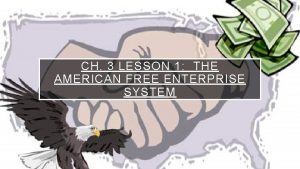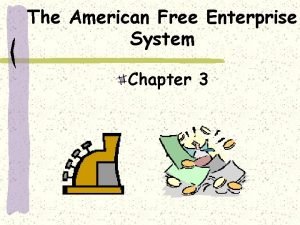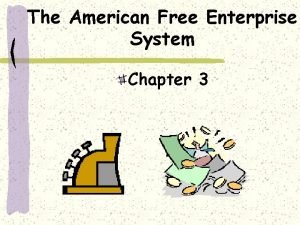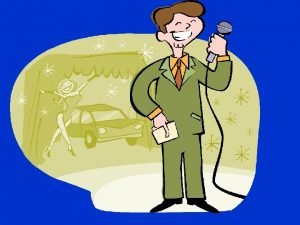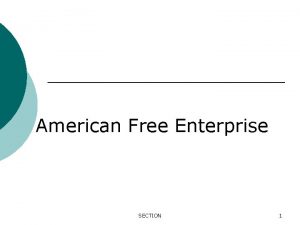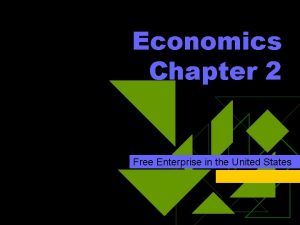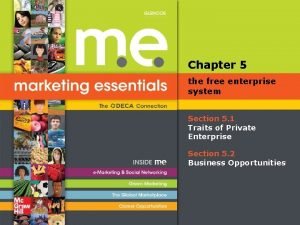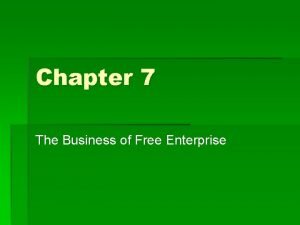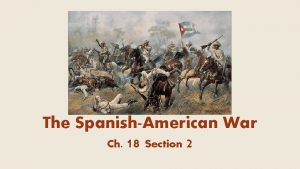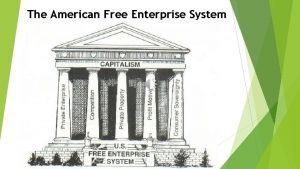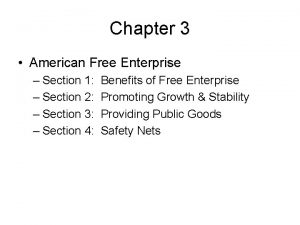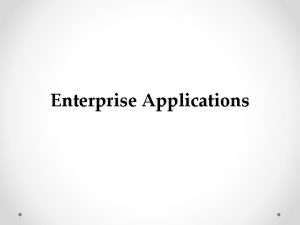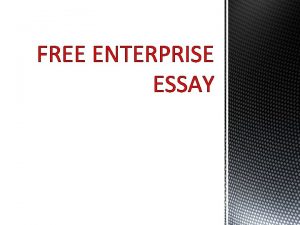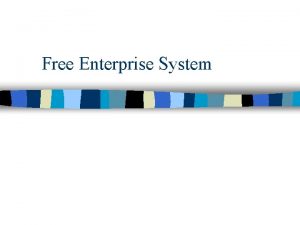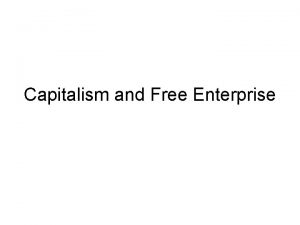Chapter 3 The American Free Enterprise Systems Section











- Slides: 11

Chapter 3: The American Free Enterprise Systems Section 2: How Does Free Enterprise Allocate Resources? pg. 78 -83

The Roles of Producers and Consumers • In the marketplace, consumers buy products for their personal use from producers who make or provide goods or services. • In these exchanges, consumers look to get the best deal for the money they spend. • Producers, on the other hand, are looking to earn the most profit from these transactions.

Profit • Profit is the money left over after the costs of producing a product are subtracted from the revenue gained by selling that product. • Seeking opportunities to earn profit is one way producers help allocate scarce resources in the economy.

Producers Seek Profit • An example of how producers help to allocate resources could be a neighborhood coffee shop. • The owners of the coffee shop, motivated by the desire to earn profits, charge the highest price consumers are willing to pay. • The possibilities for good profits lead to other people opening more coffee shops. • As a result, productive resources that might have been used in some other kind of business are directed toward the coffee shops. • The profit seeking of producers, then, has helped in the allocation of resources.

Consumers Vote with Their Wallets • Consumers also play an important role in allocating resources in a free enterprise system. • When consumers choose to buy a product, they are “voting” for their choice against competing products. • These “votes” help determine what will be produced in the future, since producers, seeking opportunities to profit, try to provide what consumers want.

Government in the U. S. Economy • As we learned in the last chapter, the U. S. Economy, though based on the market system, is mixed. • Government is an important element in the American economic system, but its role is relatively limited. • This type of mixed economy, which includes some government protections, provisions, and regulations to adjust the free enterprise system, is sometimes called a modified free enterprise

Modified Free Enterprise • As we saw in Chapter 2 (Figure 2. 4), the economy can be viewed as a stream of resources and products moving in a circular flow, between households and businesses. • Money also flows between households and businesses, facilitating this exchange of products and resources. • The government also fits into this circular flow. • Government exacts cost and dispenses benefits. • See Figure 3. 4 on page 80.

Government in the Circular Flow Model pg. 80 • Locate the two main economic decision-makers at the right and the left of the chart: Households (owners of resources) and businesses (makers of products). • The two markets in the economy, the product market (for goods and services), and the factor market (for economic resources), are located at the top and the bottom of the chart. • The outer orange arrows show the flow of money. • The inner blue and pink arrows show the flow of resources and products.

Government in the Circular Flow Model pg. 80 • The government is located in the center of the chart. • Like the other key actors in the circular flow, the government is both a consumer and producer. • The government is a consumer in the resource market, spending money to buy the factors of production. • It is a consumer in the product market, spending money in exchange for products.

Government in the Circular Flow Model pg. 80 • Now locate the arrows that run between government and households and government and business firms. • Government is a producer here, providing goods and services to both households and businesses. • Government collects money from households and businesses, in the form of taxes, as payment for these goods and services. • It covers the costs of what it produces with this money. • Government also uses this money to make purchases in the resource and product markets, and the cycle continues.

Government • Figures 3. 5 & 3. 6 on pg. 81, show that the government is a major consumer of both resources and products. • All levels of government, local, state, and federal, employ almost 22 million workers. • This is equal to about 16% of the labor force. • Further, the government (at all levels) spends about two trillion dollars a year on goods & services.
 What is a modified free enterprise economy
What is a modified free enterprise economy Assignment 3: free enterprise system
Assignment 3: free enterprise system How are conflicts among economic goals resolved?
How are conflicts among economic goals resolved? Topic 2 free enterprise and other economic systems
Topic 2 free enterprise and other economic systems Business cycles occur in free enterprise systems because
Business cycles occur in free enterprise systems because Pictures of free enterprise
Pictures of free enterprise Chapter 2 free enterprise in the united states answer key
Chapter 2 free enterprise in the united states answer key Chapter 5 the free enterprise system
Chapter 5 the free enterprise system Chapter 7 the business of free enterprise
Chapter 7 the business of free enterprise Putting the enterprise into the enterprise system
Putting the enterprise into the enterprise system Enterprise
Enterprise Valeriano butcher weyler
Valeriano butcher weyler
